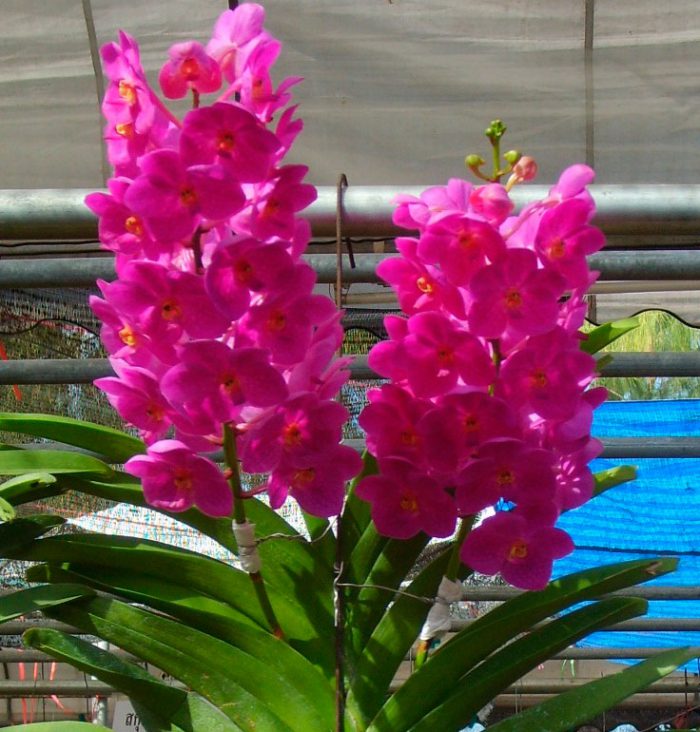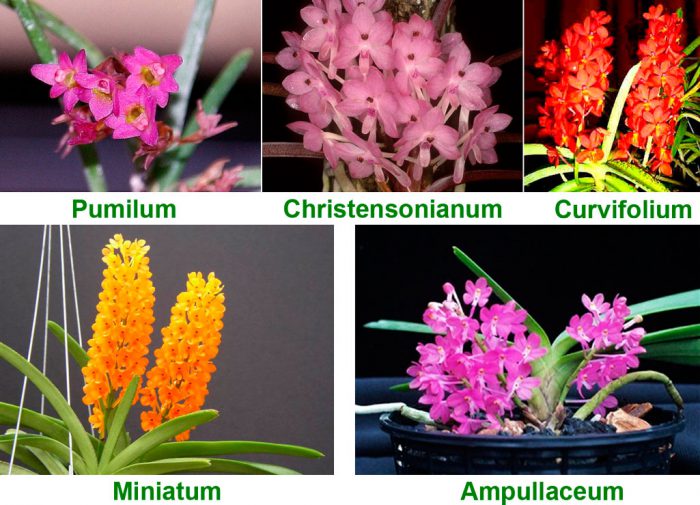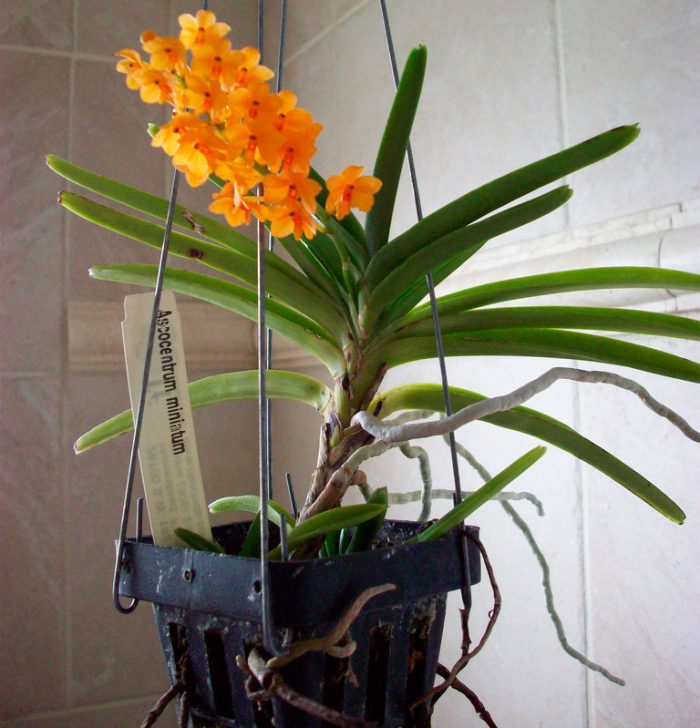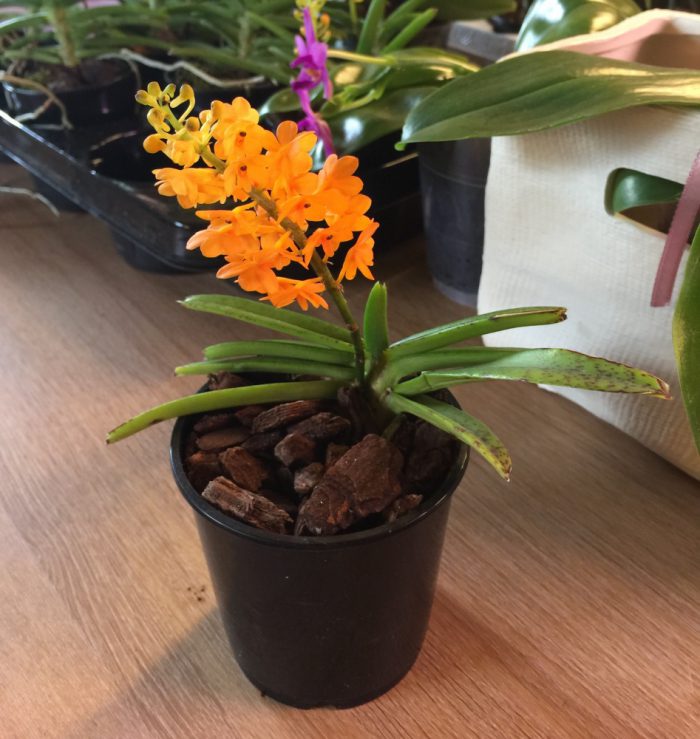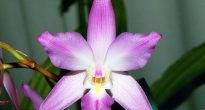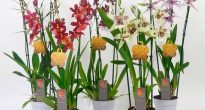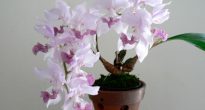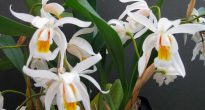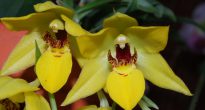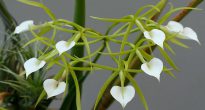The small genus Ascocentrum (Ascocentrum) belongs to the orchid family. According to information from different sources, it unites 6–13 species represented by dwarf lithophytes and epiphytes. In nature, they can be found in the Philippines, as well as in Asia.
Such a plant is distinguished by a monopodial growth pattern. This means that it has only 1 stem, which does not branch, and its gradual growth continues until the death of the flower itself. A rather thick aerial root system on its surface has a layer of velamen, which has a porous structure and is painted in a white-silver color. Two-row, vaginal, alternate leaves are colored greenish-red and have an arcuate-curved shape. On the shoot, they are placed quite tightly. Hard and thick leaves have a belt-like shape, and at the tip they have uneven teeth in the amount of 1 to 3 pieces. The leaves are 2 centimeters wide and 30 centimeters long.
Flowering is observed from mid-spring to early autumn. Short peduncles grow from the lower leaf axils, which can reach a height of 8 to 20 centimeters. They bear rather dense, multi-flowered inflorescences with a cylindrical shape. The zygomorphic flowers are rather small, their diameter is only 1.5–2.5 centimeters. 3 sepals (sepals) are obovate or oval in shape. They are located in relation to each other at an angle of 120 degrees. The color and shape of sepals and petals are almost identical. 2 oppositely lying petals (petals) have the same angle to each other as sepals (120 degrees), as a result of which the corolla itself has a relatively regular shape. However, the actinomorphism was prevented by the three-lobed lip (3rd petal), which is not very large and rather narrow. The lip protrudes forward and has 2 lateral, vertically positioned, processes. The lip in the back ends with an elongated hollow outgrowth (spur) and it is in it that the secreted nectar accumulates. This feature of the plant influenced the formation of its name, so, in the Greek language "ascos" means "bag", and "kentron" - "spur".
As a rule, the types of this orchid are very similar to each other and they differ only in the size and color of the flower:
- A. dwarf (A. pumilum) - the height of the bush reaches 4-6 centimeters, and the color of the flowers is mauve;
- A. christensonianum - bush height from 15 to 40 centimeters, pinkish-white flowers;
- A. curvature (A. curvifolium) - the height of the bush is from 15 to 25 centimeters, the color of the flowers can be orange, red or yellow;
- A. miniatum (A.miniatum) - the height of the bush is from 10 to 20 centimeters, the color of the flowers can be orange, red or yellow;
- A. bubbly (A. ampullaceum) - the height of the bush is from 7 to 13 centimeters, the color of the flowers is from red to pinkish-purple.
Content
Ascocentrum orchid care at home
This genus of orchids is considered one of the most demanding to care for, and it needs special attention. Such a plant is suitable for growing only by experienced growers. But at the moment, thanks to breeders, a large number of hybrid forms have appeared, which both experienced and novice orchidists can afford to grow.
Illumination
It is quite light-requiring, it needs a fairly bright (about 3500 lux), but always diffused lighting. It is not recommended to expose it to direct rays of the sun, however, the plant can be taught to them, but this must be done gradually. For placement, it is recommended to prefer western and eastern windows.
In the autumn-winter period, the plant needs additional lighting. It is worth remembering that daylight hours throughout the year should be approximately equal to 10 to 12 hours.
Temperature regime
The temperature regime should be the same all year round. In this case, this orchid simply needs a difference in daily temperatures. The difference in daily temperatures should be at least 10 degrees. So, it is best if the temperature is from 24 to 31 degrees during the day and from 10 to 20 degrees at night.
In the warm season, experts do not recommend transferring Ascocentrum to fresh air. The fact is that a sharp change in the habitat will cause severe stress to the plant and lead to its illness.
Earth mix
As a rule, this genus of orchids is grown either in special hanging baskets or on blocks, without using a substrate. The fact is that air roots need oxygen in large quantities and light. The block is often a large piece of pine bark. On its surface, the root system of the flower is reliably fixed, while all the roots must first be wrapped with a not very thick layer of coconut fiber or sphagnum, which will help to avoid too rapid evaporation of moisture. Young plants, as well as dwarf forms, can be grown in a pot made of transparent material, while filling it with pieces of pine bark, which not only support the plant so that it does not fall, but also help reduce the rate of drying of the roots.
How to water
This plant does not have a dormant period, and therefore it must be watered the same all year round. Watering is recommended by immersion method. To do this, water is poured into a basin and a block is lowered there for a while, if possible, you can immerse the whole plant itself. After 15–20 minutes, the orchid must be pulled out of the water and placed in its usual place. Thus, experts advise watering the flower once a day.
Humidity
This plant needs high humidity. So, it should be at least 70 percent (but better from 80 to 90 percent). To increase humidity in an apartment, it is imperative to use household humidifiers and steam generators.
Fertilizer
The plant is fed once every 4 weeks. To do this, use special fertilizers for orchids, and take ½ part of the dose recommended on the package. Dissolve fertilizer in water for irrigation. And it is also recommended to carry out foliar feeding once a month. To do this, the leaves must be sprayed with a weak solution of the nutrient mixture.
Possible difficulties
If you take care of the plant correctly, then pests and diseases are not afraid of it.However, as a result of a violation of the temperature regime, lack or excess of light, improper watering, insufficient humidity, the complete absence of temperature drops during the day, this kind of orchid can slow down its development or even die.

